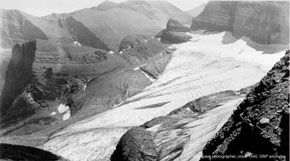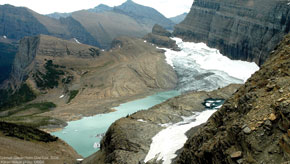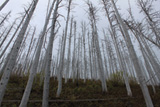Time and Change
The earth’s cooler temperatures of the Little Ice Age that ended 12,000 years ago brought massive amounts of snow that warmed and melted during summers, refreezing in winters to create glaciers. Today, the earth’s warmer temperatures are melting those glaciers faster than they are rebuilt by new snow. In 1850 there were an estimated 150 glaciers on the land that eventually became Glacier National Park. At the time the park was created in 1910, there likely remained over 100 glaciers. At the writing of this book there are 25 remaining glaciers, all of which are expected to be gone from the park by 2030 if the current trend of increasing temperatures continues. In order to be named, a glacier must be 25 acres (10 hectares) or larger. Numerous smaller ice fields remain unnamed.
Mountain snowpacks have declined, rain often falls when snow previously occurred, and the spring runoff begins earlier. Early runoffs can contribute to an increased potential for flooding, while decreased snowpack leads to less water available in the dryer months. As mountain ecosystems are altered by changes in weather patterns and water availability, a near-term decline or loss of vegetation will occur. Changes in vegetation will in turn alter or reduce food sources and cover for a variety of wildlife. This trend over time will profoundly affect both aquatic and terrestrial species, humans included. While scientists do not yet fully understand all of the impacts of global climate change, the disappearing glaciers in Glacier National Park and around the world are one of the indisputable and tragic consequences.
Scientists from the U.S. Geological Survey have studied climate change by monitoring small alpine glaciers in Glacier National Park. These glaciers provide an excellent focus for their research because they are influenced almost entirely by changes in temperature and precipitation. Changes in glacial size and formation reflect decade-scale changes, revealing long-term climatic changes. Climate records and photographs show that 38 square miles (99 km2) of ice covered Glacier National Park in 1850. By 1968, only 10 square miles (26 km2) of ice remained. In the forty years that followed, the Park lost over one-third of that; now just 6.6 square miles (17 km2) remain.
 |
|
 |
|
| Figure 2.20: Sperry Glacier, 1913. Source: National Park Service |
Figure 2.21: Sperry Glacier, 2008. Source: U.S. Geological Service |
 |
 |
| Figure 2.22: Grinell Glacier, 1940. Source: National Park Service |
Figure 2.23: Grinnell Glacier, 2006. Source: U.S. Geological Service |
In 1997, USGS Research Ecologist Dan Fagre and his staff initiated the Repeat Photography Project in Glacier National Park. They took photographs of the same areas of the park that had been photographed in much earlier images. Their photos captured the dramatic recession of glaciers previously documented by research data, but in a more widely understood visual format. The earliest photographs of the land were taken by a survey expedition in 1861 prior to Glacier becoming a park. In 1887 photographs were taken by Lyman Sperry on what became Sperry Glacier, and in the 1890s by George Bird Grinnell on several other glaciers. The earliest photos deemed useful by the Repeat Photography Project were those taken by W.C. Alden in 1900.
Since the start of the project in 1997, historic photos of glaciers have been collected from the Glacier National Park and National Park archives as well as from private collections. Painstaking efforts by project participants to return to the exact locations to take current day photographs have revealed dramatic glacial retreats. The repeat photographs have also captured public attention, been utilized by numerous scientists and educators, and have inspired artists to create unique visuals of this spectacular, changing landscape.
Compared to the expanses of geological time in which most major changes to the earth take place, human existence seems impossibly brief. Yet in our short time on Earth, human activity has transformed over 80% of the earth’s surface. Locally, we can see the Flathead Watershed changing in our lifetimes. Photographs of marshes we once knew as lakes and vegetated mountain cirques that once held massive glaciers help us to imagine how more than a billion years of the earth’s history has slowly unfolded, and how it continues to be written today.
The consequences of climate change in the Flathead Watershed are seen not only in the glaciers themselves, but in the changing dynamics of forest ecosystems and freshwater fisheries. Early snowpack melt and the increasing number and length of hot days contribute to increases in fire frequency and area burned. Increases in temperature have also been linked to changes in insect infestations such as the Mountain Pine Beetle which has expanded its range to higher elevations and further toward the east.
The cold-water fisheries of the Flathead Watershed depend on stream temperature regulation from glaciers. Native bull trout and westslope cutthroat trout are very temperature sensitive, making them important indicators of climate change. Warmer waters along with habitat degradation and nonnative species introductions have contributed to a decline in the numbers of these native fish. A warming climate will exacerbate this decline. The loss of extremely cold days and increase in extremely hot days in the future will be closely studied by scientists in an effort to provide the best information for resource managers in the Flathead Watershed.
The beauty and abundance of the Flathead Watershed, our numerous lifestyle choices, and the opportunities for diverse recreation are a result of our climate, and will change as it changes. In the distant past, the Flathead Watershed existed only as a deep frozen lake. In our near past, aboriginal people discovered the variety of lands once covered in ice and learned to live off their bounty. Today, we ski across snow-covered mountains, fish in lakes and rivers, and grow crops and raise livestock on fertile lands. Someday in the future, children will ask their parents how Glacier National Park got its name. The Flathead Watershed has a unique climatic history to which will be added the ongoing story of Glacier National Park.

